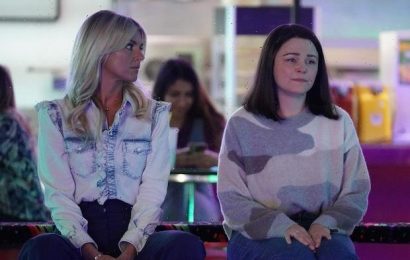In some respects, “Mona Lisa and the Blood Moon” — Ana Lily Amirpour’s latest feature, premiering at this year’s Venice Film Festival — could be called a return to form, or at least a return to the tropes and visual tendencies the Iranian-American director showed in her promising 2014 debut, “A Girl Walks Home Alone at Night.” After Amirpour’s disastrous collaboration with Netflix in “The Bad Batch,” “Mona Lisa” feels like a movie that is of a kind with her initial preoccupations. That is to say: like her first, it’s a film of maximalist stylings, self-conscious hipsterdom, and women who stalk nocturnal streets solo, undermining audience expectations of their vulnerability in possibly supernatural ways.
The film begins with Mona Lee (a formidable Jeon Jong-seo), a 22-year-old Korean-American who has, for most of her life, been locked in a secure psychiatric unit, borderline catatonic and straitjacketed: until she escapes. In the opening scene, Mona’s sneering, vaguely Republican-sounding nurse taunts her, only to discover that the vacant-looking girl is the locus of some terrifying power. With merely a fixed stare, Mona can force people to do her bidding, with a flick of her head or arm making them marionettes who will open doors, hand her cash, or brutally injure themselves.
And so she vanishes into the New Orleans night, dangerous and hungry, bumping into a series of characters who will shape the rest of her journey through the film in equal poses of alienation, from a single-minded policeman who chases her (the hilarious Craig Robinson, playing it unusually straight) to a good-hearted drug dealer called Fuzz (Ed Skrein). Eventually, Mona chances into a parking lot altercation and offers some assistance to foul-mouthed stripper Bonnie (Kate Hudson, dazzlingly outfitted in heels and belly tops with canary-yellow nail extensions to boot). Bonnie gives the waif a place to crash for the night.
Seeing an opportunity to use Mona’s powers for financial gain, the pair come up with a con. Bonnie’s son, a precocious 11-year-old Charlie (Evan Whitten), does more parenting of his mother than vice versa, and seems to befriend Mona on the basis of their mutual antipathy for the world around them. (“Do you like people?,” Mona says viciously to a cop at one point.) Each individual cast member is doing good work here; Hudson is a whirling dervish, and Skrein in particular seems to brighten every scene he’s in with his bucket-hatted, comic presence.
Amirpour goes for broke visually, with dolly zooms, psychotropic daubs of neon, and constant perspective swaps, utilizing a carnival-esque bag of tricks to suggest that something wacky is happening under a bright and ominous Louisiana full moon. Policemen on night patrol and strippers at the end of shifts all acknowledge that everyone’s crazier under that moon, an old superstition that seems to underline the night’s events. A locomotive dubstep soundtrack proves both dissonant and surprisingly catchy, helmed by excellent Italian composer Daniele Luppi.
All of this to say, Amirpour is good at the surface-level stuff. “Mona Lisa and the Blood Moon” has plenty of cinematic forebears, from hip takes on the trashy American South (“Spring Breakers,” “Zola”) to the kooky voodoo vibe of another New Orleans-set movie, “Angel Heart.” Jim Jarmusch also seems like an omnipresent influence, with Amirpour borrowing from his uncanny nighttime sojourns, oddball friendships, and tone of deadpan disaffection; but there is none of the buried existential malaise here that makes Jarmusch so effective.
Themes of outsiderdom, weirdo camaraderie, parenthood, and even institutional abuse are all present, but not especially unpicked or engaged with. Amirpour’s fascination with petite young women who seem to be vulnerable to the vagaries or violence of men — and who reverse that with gusto — doesn’t feel especially novel. Tens of dozens of TV shows and films have stolen the image of uncanny power in an unassuming vessel — a kid, a cute animal, or a small woman — at this point, and Amirpour doesn’t seem to have much else to say about it.
The fact of Mona’s being Asian is referenced or alluded to several times; someone mistakes her for Chinese rather than Korean, and the racist stereotype of the submissive or meek Asian woman is displaced repeatedly, in a clear attempt on the director’s part to explode gross assumptions. But in the final analysis, none of this adds up to very much. Even when the film goes for the heartstrings — mainly in the dysfunctional relationship between young Charlie and his mother — there’s something that feels inconsequential about it in the face of that preeningly music-video-esque aesthetic. Most of the movie’s machinations seem merely in service of deepening the central gambit, which is to follow Mona’s journey and to look cool while doing it.
On that front, it succeeds, but the movie’s charms are limited when the originality it purports to offer only feels like a bit of a costume. Underneath, it doesn’t feel all that original after all. “Mona Lisa and the Blood Moon” may be pretty to look at it, but it seems flimsy when held up to the light.
Grade: C+
“Mona Lisa and the Blood Moon” premiered at the 2021 Venice Film Festival. It is currently seeking U.S. distribution.
Source: Read Full Article







